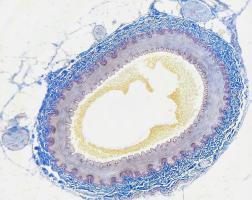The 7 differences between arteries and veins
The circulatory system is a vital system for the human being, since it allows the circulation of the blood and with it the oxygen and nutrients that all our cells need to stay with lifetime. Said system is configured in addition to the heart by the blood vessels, there being several types of different sizes.
The two types of great vessels that are part of the circulatory system are arteries and veins. These are glasses with roles and characteristics that make them different from each other. In this article we are going to look at some of the main differences between arteries and veins.
- You may be interested in:Parts of the human brain (and functions)"
Blood vessels
It is understood as blood vessels those hollow tube-like structures through which the blood circulates and that together with the heart configure the cardiovascular system. There are several types of blood vessels, which are responsible either for carrying the blood pumped by the heart to the organs or for making this blood return to the heart.
Between these blood vessels we can find large vessels and small vessels. The small vessels are the capillaries, arterioles and venules that turn out to be extensions of arteries and veins and that allow oxygen and nutrients to reach the cell or the blood is returned from the organ or cell to the vein. The great vessels are the arteries and veins, which carry and direct the blood either towards the organs (arteries) or towards the heart (veins) and which are inserted into them through the capillaries.
- You may be interested: "Types of neurons: characteristics and functions"
Main differences between veins and arteries
Although from the above we can already deduce one of the main divergences between the two, both this and other differences between arteries and veins are indicated below.
1. Principal function
One of the main differences between arteries and veins, and the best known, is that they perform opposite functions: while the arteries carry blood from the heart to the organs, the veins carry blood from the organs to the heart.
2. Composition of the blood they carry
Another of the main differences, linked to the previous one, is the type of blood they carry: While through the arteries travels blood with a high level of oxygenation, the blood carried by the veins has very low levels of this component and it is abundant in residues of organic functioning, such as CO2.
The only exception we see in the communication between the heart and lungs, in which arteries and veins carry out functions opposite to the usual ones: the arteries carry the blood with carbon dioxide and without oxygen to the lungs (from which the CO2 will be expelled and will reoxygenate the blood through respiration) while the veins are responsible for carrying oxygen-rich blood to the heart.
This is linked to its function: oxygenated blood from the heart is sent to the organs, which allows them to work, and subsequently returns to it so that it can and be enriched with oxygen from lung activity and through the same medium to expel the CO2 product of the activity of the organism.
- Related article: "20 recommended medical books for the curious"
3. Pressure at which your content circulates
Another major difference between arteries and veins is the pressure with which the blood circulates. In the arteries there is high blood pressure derived among other things from its thickness, capacity for contraction and elasticity. On the contrary, the venous pressure is much lower, taking longer to get the blood from the organs to the heart than vice versa.
4. Presence or absence of valves
The arteries do not have any type of valve, being their high level of pressure derived from their size, thickness and elasticity and originating the movement of blood in the heart. In the case of veins, the existence of small internal pumps and valves can be observed that allow the blood to be directed towards the heart and prevent it from going back to the organs.
5. Size, thickness and brittleness
Veins and arteries they also differ in their resistance and in the thickness of their walls. The arteries have a thick wall and are capable of contraction, being very resistant. In contrast, a vein is much more fragile and brittle, having much thinner and weaker walls. Also, veins tend to be larger than arteries.
6. Structure
This is due to its structure. Both great vessels have an inner layer of endothelial tissue, a middle layer of muscle tissue and an outer layer of connective tissue. In arteries the muscular layer is much thicker than in veins, which makes them stiffer.
7. Interpersonal variability
Another difference can be found in that while the veins have a highly pattern and arrangement variable depending on the person, the arteries generally appear in the same locations in most beings humans.


